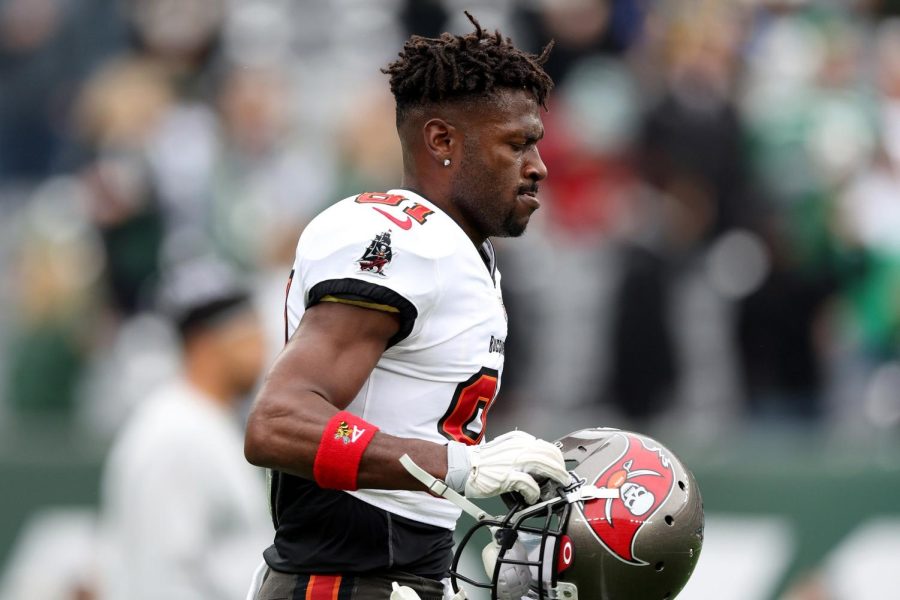What Antonio Brown’s Outburst Means for the NFL and CTE
January 10, 2022
If you were watching NFL football on January second, or on any form of social media, you saw the video of Tampa Bay Buccaneers wide receiver Antonio Brown taking off his jersey and pads, setting them down, chucking his gloves and sweat bands into the crowd at Metlife Stadium, and happily walking off the field and into the locker room in the middle of the game. Prior to the outburst, fans could see Brown being consoled by fellow receiver, Mike Evans. However, Brown would hear none of it and left the game in the third quarter. Veteran Tom Brady led the team past the New York Jets, a game that was close until the end. After the players and coaches left the field, fans anxiously awaited the response that head coach Bruce Arians, Brady, and other members of the team would have to the situation.
When asked about Brown, Arians said, “[Antonio] Brown is no longer a Buc.” That was all the attention that the reigning Super Bowl champion head coach gave the situation at the time.
Later on during the same day, Brown posted a photo of himself on the field to Instagram, captioning it, “Big MAD (Making a Difference) Thanks for the opportunity.” While that was the first fans heard from Brown on Instagram, it was certainly not the last.
Immediately following the incident, several conflicting reports surfaced regarding the reason as to why Brown left in the first place. The one that was most prominent in the news was the Arians had benched Brown. Another one was that Arians told Brown to enter the game twice, but Brown refused. However, as Brown became more vocal, we learned that the incident was caused by something beyond the sidelines.
As the week progressed, Brown and his attorney began to claim that the one-time Super Bowl champ was playing on a foot injury that required surgery, a claim which Arians denied knowing about. Brown eventually released text messages between him and Arians from the night before the game, as well as the morning of, telling his coach that he was not sure if he would be able to play, to which Arians responded that playoffs were approaching, and there was no time for anyone on the team to rest. The texts, while they caught several people off guard, proved that Arians knew about Brown’s injury but disregarded it completely. The story, however, does not end there.
On Wednesday, model Ava Louise posted to her own social media, claiming that she had been staying in the Buccaneers team hotel the night before the game and that Brown went up to her hotel room to meet her. According to Louise, she and Brown had been speaking for four years and January first was the first time that the two had met in person. Louise claimed that Brown told her to “watch what he does tomorrow”, something she thought nothing of until she witnessed what millions of people did on Sunday. Late on January sixth, Louise posted a photo of a positive COVID test, with the caption, “@bucaneers test your team!!”.
Early on Wednesday morning, the Buccaneers officially released Antonio Brown. Tampa Bay has not been the first team to release him, however. In 2019, Brown was traded from the Pittsburgh Steelers to the now Las Vegas Raiders. He went to Oakland and was ready to play. However, Brown held out during the first two weeks of training camp due to his helmet not being certified by the NFL. After much back and forth with the NFL, general manager Mike Mayock, and coach John Gruden, Brown asked for his release from the Raiders and was granted his release on September seventh, just hours after the request was made. The news of Brown finding out about his release went viral. Later the same day, Antonio Brown signed a one-year deal with the New England Patriots. Similar to his time with the Raiders, Brown’s time with the Pats was short-lived. After playing one game with the team, Brown was released amid allegations of sexual assault by a personal trainer. The woman who made the accusations posted photos of text exchanges between the two while the incident was happening. New England released him relatively quickly, ending his eleven-day tenure with the team.
Amid Brown’s outburst in East Rutherford, many players have come to Brown’s defense, saying that we do not know what is going on with him in his personal life and that he could be suffering from chronic traumatic encephalopathy, also known as CTE, the disease is a result of several blows to they head and has been found in several former NFL players. Despite the ongoing issue, the league has been criticized for years over how they have handled the CTE and concussion issues that players face. Some former players that have taken their own lives or even the lives of others have had their brains examined in autopsies. In those autopsy reports, it had been found that the players suffered from CTE.
People with CTE often suffer from short-term memory loss and fast changes in their mood. There have been four stages of CTE identified, which are:
Stage 1: Marked by headaches and loss of concentration
Stage 2: Depression, mood swings, memory loss, and frequent headaches. The patient may also experience frequent outbursts
Stage 3: Memory loss, visual deficits, and symptoms of apathy
Stage 4: Language deficits, paranoia, parkinsonism, and motor deficits.
The disease has been around for years, but it was Dr. Bennet Omalu that first brought up the disease in retired professional football players. Omalu and his discoveries were explored in the movie “Concussion” starring Will Smith, which brought the issue into pop culture.
While rules in the NFL regarding tackles and contact have become stricter, the issue has not completely gone away. Retired players have been diagnosed and the case of Antonio Brown shows how it can affect their actions.
To learn more about CTE, please visit: https://concussionfoundation.org/CTE-resources/what-is-CTE










